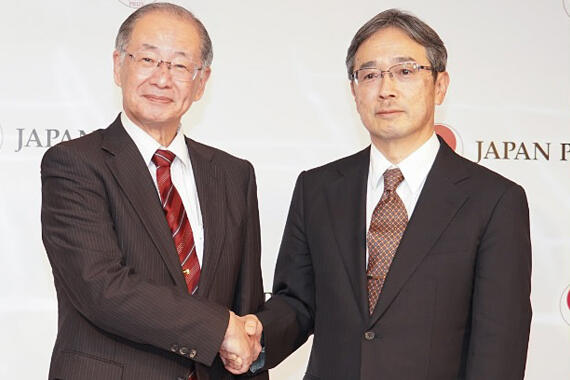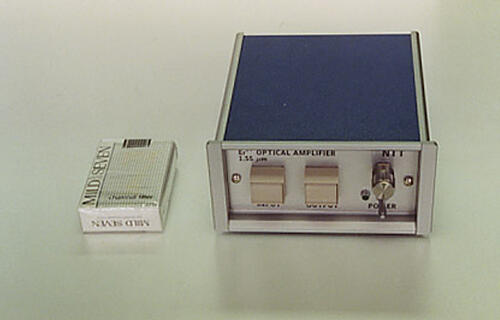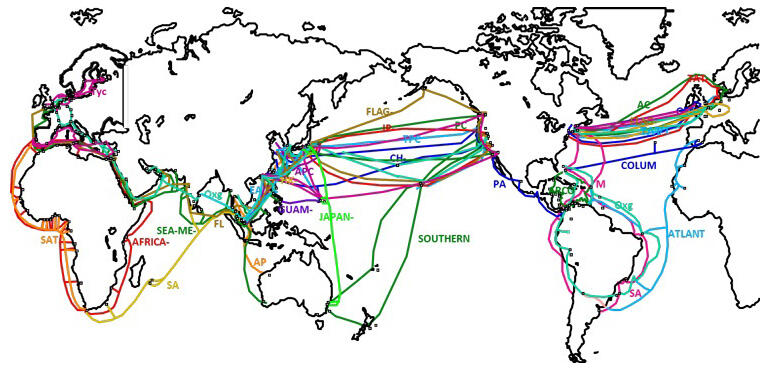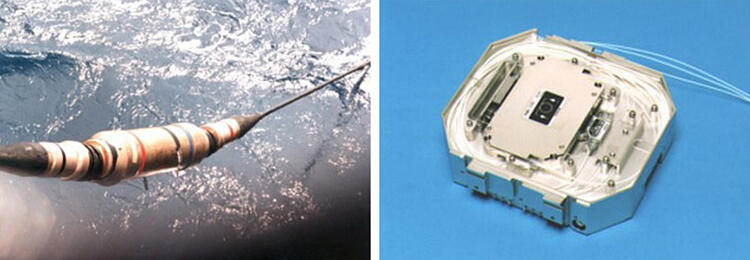The Japan Prize Foundation presented the 2023 Japan Prize to Distinguished Professor/Specially Appointed Professor Masataka Nakazawa (70) of Tohoku University and Principal Researcher Kazuo Hagimoto (68) of National Institute of Information and Communications Technology (NICT) in the field of 'Electronics, Information, and Communication.' What are the results of their research on devices such as the semiconductor laser-pumped optical amplifier, which were praised as "Paving the way for 'long-distance, high-capacity optical fiber network,' the core technology that supports the global internet society?" Science Portal followed up on the commemorative award lectures and interviews with both researchers.

(photo taken on April 14)
Light energy attenuates to approximately 1% at 100 km
Information on the internet can be transmitted and received at high speed by converting electronic signals from personal computers and other devices into optical signals. Regarding fibers used for transmission and reception, in 1966, Dr. Charles K. Kao, physicist, realized the advantages of optical fibers made of high-purity glass and published a paper on their basic technology. Optical fibers have been practically applied since the 1970s, and Kao was awarded the Nobel Prize in Physics in 2009.
Despite its high purity, the energy of light attenuates rapidly as it travels through fiber. At a distance of 100 km, only approximately 1% remains. Hagimoto said, "Mt. Fuji is approximately 100 km away from the NTT's research institute in Yokosuka, where I was working at the time. On a clear day, I could see Mt. Fuji, and I felt that even if the glass plates were lined up for 100 km, I would still be able to see 1% of the mountain," and laughed.
To traverse the Japanese archipelago from Hokkaido to Okinawa, a distance of approximately 3,000 km, or to build an international communication network between continents, a distance of approximately 10,000 km, with optical fibers, it is the attenuated light during optical fiber relay that needs to be amplified efficiently.
Miniaturization by combining a semiconductor laser and erbium
Both Nakazawa and Hagimoto joined the Nippon Telegraph and Telephone Public Corporation (now NTT) in 1980. Nakazawa's initially focused research theme was on developing a device that identifies breakage points in optical fibers accidentally damaged during civil engineering work and other incidents. He was developing a laser that could be passed through the fiber to detect the breakage point. While investigating related research, he learned that optical fibers doped with erbium, a rare-earth element, can amplify light.
Nakazawa said, "At that time, the team led by Professor David Payne of the University of Southampton in the U.K. and Bell Laboratories in the U.S. were independently developing amplifiers, and the competition was fierce. I was proud of my achievements when fruit was borne, but my body was tired, and my heart always ached at the thought of my competitors catching-up to me. I got over it because I was 35," recalling those days fondly. The focus of the competition was how to energize erbium, which amplifies light, into an excited state without large-scale equipment.
Existing optical amplifiers convert optical signals into electrical signals, electrically amplify them, convert them back into optical signals, and send them out again, but they are large and require high electrical power. Nakazawa assumed that light can be amplified by combining erbium-doped fibers and irradiation with an InGaAsP (indium-gallium-arsenic-phosphorus) semiconductor laser, which he had developed for a breakage point search device. In 1989, he developed a prototype semiconductor laser-pumped optical amplifier that could efficiently respond to a wide spectrum of light. It was 10 cm2, one-hundredth the size of a conventional optical amplifier and powered by batteries. "I did not research optical amplifiers from the beginning. New ideas were born when evaluating alternatives," he emphasized.

(courtesy of the Japan Prize Foundation)
Leading international standardization ahead of foreign competitors
After developing the prototype, Hagimoto, who was also working for NTT, quickly demonstrated that long-distance transmission of 212 km was possible. Since his presentation at an international academic conference in February 1989, competition with overseas competitors, such as Bell Laboratories, intensified. Hagimoto looked back, "I have lived such a life that I ate dinner at a company-owned house and returned to the office to conduct experiments even while my one-year-old son cried. Even if you win the competition once, Western research institutes will try to overtake you with more sophisticated results at the next international academic conference. We were always expected to produce results that were one step ahead, and there was an atmosphere in which Western researchers would not recognize us unless we continued to produce good results."
At an international academic conference held in July of the same year, Hagimoto and his colleagues took another step forward in multi-relay transmission and advanced higher output. They also confirmed that erbium-doped optical amplifiers can amplify light of various wavelengths all at once without interference. Wavelength division multiplexing (WDM), in which multiple wavelengths of light are transmitted through a single optical fiber, has further increased the capacity of information and communications. By leading the international standardization of amplifiers among international competitors, they paved the way for terabit optical transmission, which can transmit one trillion (tera) bits of information per second.
This amplifier has been widely used; KDD (now KDDI) used it for the first optical submarine cable across the Pacific Ocean. Its use is now widespread to the extent that personal information can be exchanged through international submarine optical cable networks that transmit and receive diverse and high-capacity information, including broadcasting international programs globally through the internet.

(courtesy of the Japan Prize Foundation)

(courtesy of the Japan Prize Foundation)
Expectation for 'omnivorous' combined with wireless technology as well
The amount of information communicated through the internet has been increasing. The achievements of Nakazawa and Hagimoto have greatly contributed to widely used SNS and cloud services. However, significantly more information will be communicated with the advent of 5G (fifth-generation mobile communication system), which supports Society 5.0, and the 6G that follows.
In this context, Nakazawa said, "I think it is important for future researchers to be 'omnivorous' to cope with capacity increase and speed up of communication. In future communication technology, if not only light but also radio waves can be used as the same electromagnetic waves, we must develop the technology, and we can expect the emergence of '3M technology,' which is a fusion of wired and wireless communication."
3M technology is an acronym for (1) multi-level modulation, (2) multi-core fiber, and (3) multi-mode control.
- (1) is a technology that increases the amount of transmitted information by changing the properties of light and is said to have been put to practical use.
- (2) is a fiber that is not made of glass but has empty pores through which nothing passes and is expected to be put to practical use soon.
- (3) is a technology that increases the number of transmitting and receiving antennas.
By 2050, information and communication are expected to increase further in terms of speed and capacity, and transportation field will change significantly, with flying cars, drones, and automated driving. In addition to medical fields such as home medical care and remote surgery, the application of information and communication technology is unlimited, including development of various services using the metaverse (virtual space) and the large-scale simulations of disasters. The use of 3M technology is the key to this.
(NAGASAKI Midoriko / Science Portal Editorial Office)
Original article was provided by the Science Portal and has been translated by Science Japan.




